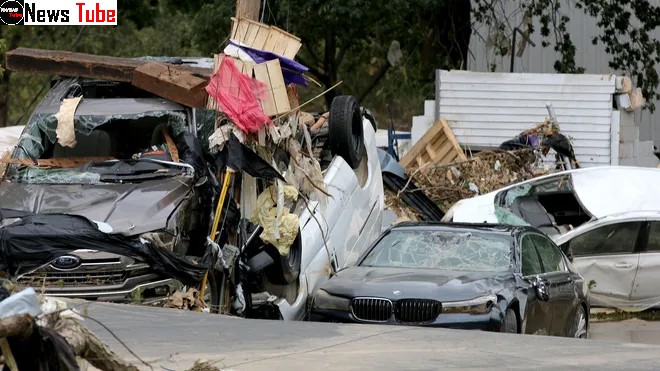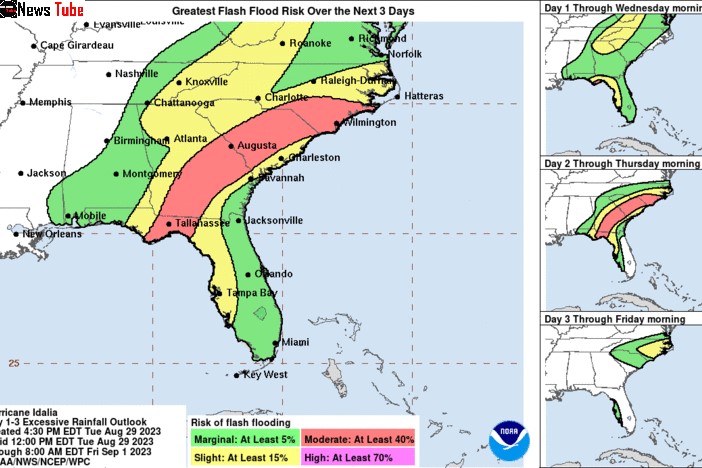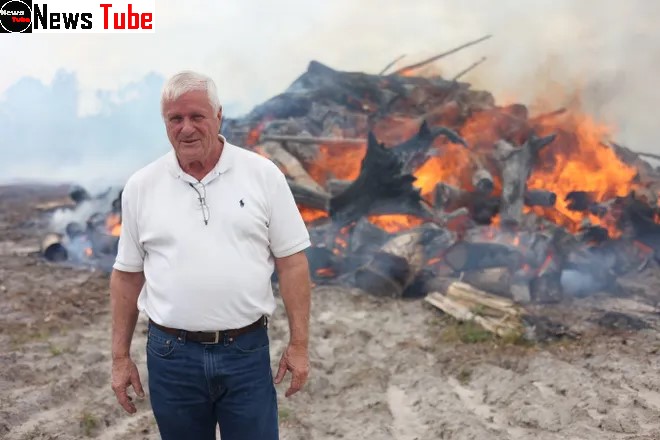
The destruction after Hurricane Helene is still unraveling because the storm caused wide devastation across several southeastern states. It has taken 90 lives when it made landfall as a Category 4 hurricane, came ashore, and tore through several states with one of the worst hits in North Carolina.
- Power Outages and Infrastructure Damage
- Rescue and Recovery Operations
- Tennessee and Other Affected States
- Gas and Cash Shortages in Asheville
- Asheville’s Devastation and Ongoing Efforts
- Flooding and Landslides in North Carolina
- Helene’s Place in History
- Reaching Loved Ones and Relief Efforts
- How to Help Victims of Hurricane Helene
- Weather Patterns Behind Helene’s Impact
- Future Storms Brewing
Power Outages and Infrastructure Damage
More than 2 million people still do not have power after the storm passed, including more than 430,000 in North Carolina. Helene downed homes, businesses, and vital infrastructure. Entire communities were submerged; roads got washed away, and residents found themselves trapped either by landslides or flood waters.
North Carolina Governor Roy Cooper had to give very unpleasant news on Sunday when he confirmed 11 deaths so far. He further said the number was likely to increase as rescue efforts by emergency response teams were still going on. As of this time, more than 1,000 residents are still missing.
Of the many places hit, Buncombe County probably suffered the most: several thousand of its residents remain unaccounted for. Emergency crews are in a race against time to locate missing persons and rescue those stranded by rising waters. However, damages to infrastructure have added to the complications in rescue efforts. Roads and bridges in critical areas have either collapsed or been rendered impassable, adding to the difficulties in rescue efforts.
Rescue and Recovery Operations
The region is now fully involved in rescue efforts. Emergency crews, including water rescue and helicopter crews have rescued over 200 people stranded by floodwaters. In Buncombe County, officials estimated almost 1,000 people as missing. That number is considered to lower once communications are restored.
Ryan Cole, the assistant director of Emergency Services for Buncombe County, called the mess “biblical devastation.” His team has been working tirelessly night and day to rescue stranded residents, although he also underscored the fact that many challenges lie ahead.
Members of the National Guard were also deployed to assist in search and rescue missions and in clearing debris. Thousands of troops have been stationed across affected areas, providing much-needed aid and security. In Florida, more than 3,900 National Guardsmen are involved in humanitarian relief and rescues related to the storm.
Tennessee and Other Affected States
Hurricane Helene has also passed through Tennessee, where two people have now been confirmed dead. Several communities in eastern Tennessee are said to still be underwater. Infrastructure is severely damaged, with washed-away roads and compromised utility services. Deaths have been reported in Unicoi County and Johnson County from the flooding.
According to Tennessee officials, 153 people remained missing as of Sunday afternoon. Emergency response teams in the state continued to search for missing individuals but had faced issues with impassable roads and damaged communication lines.
The remnants of Helene have swollen rivers to record levels, forcing thousands of residents to leave their homes. A number of areas continue to experience rising floodwaters, and experts caution complete recovery could take weeks.
Gas and Cash Shortages in Asheville
In Asheville, residents experience power outages and widespread flooding. Gas stations were closed, and businesses are unable to process card payments due to the impact on their infrastructure. The couple of open gas stations and ATMs had a long queue. Businesses are well open for cash-only transactions now, as there was electricity and internet connections that worked.
Residents said they encountered roadblocks while seeking fuel and staples. Gas stations across the city are out of fuel, and many stores have limited quantities of food and water. In downtown Asheville, people stood in line for hours to get cash from ATMs.
This situation has only continued to degrade, with many residents concerned about their capability to gain access to basic resources. So far, the city has failed to establish distribution points for water, leaving the majority on their own as they wait for further word from the local government.
Asheville’s Devastation and Ongoing Efforts
Asheville got hit hardest with the furor of Hurricane Helene. Much of the River Arts District was one of the key commercial parts of the city completely submerged under water. Shops were destroyed in this area, and owners were just beginning the arduous process of assessing the damage.
On Friday, the French Broad River crested at the record of 24.67 feet. On Sunday, that river is still well above flood stage with floodwaters inundating homes and businesses across the city. Life-saving responders are still conducting welfare checks on residents whose loved ones have reported them missing.
While nearby communities continue to suffer with ongoing school closures and seriously damaged civic infrastructure, officials ask people to remain off the roads and away from hazardous flood zones as they attempt searches and rescues.
Flooding and Landslides in North Carolina
Large areas of North Carolina have been repeatedly hit by lethal landslides and flash flooding. Helene dumped up to 10 to 29 inches of rain on parts of the state, creating rivers that burst their banks. The consequence is catastrophic: thousands of homes submerged and infrastructure irreparable.
More than a quarter of a million residents do not have cell service, he added, as the complication of finding missing people. The governor asked for patience from the public as authorities try to restore communication networks and work their way through determining the extent of the disaster.
Officials are also asking people not to drive in areas where the storm has hit. Indeed, the storm has washed out hundreds of roads, making travel both dangerous and hard. Authorities are clearing debris and trying to restore access to isolated communities.
Helene’s Place in History
Hurricane Helene was one of the most destructive storms ever to happen in the United States. It is considered one of the costliest hurricanes on record, with estimates in damage falling between $15 billion and $100 billion. The storm follows the disturbing trend of billion-dollar weather disasters, a trend that is all too common these days.
On average, the country has experienced eight such disasters annually since 1980. During the past five years, however, that number has more than doubled, with the nation experiencing an average of 18 major events per year. Experts say this recent increase is due to climate change and a warming of the ocean temperatures, feeding more intense storms like Helene.
With a spate of ever costlier natural disasters, many have called for a reevaluation of insurance policies. Some insurers have scaled back coverage in high-risk areas, such as Florida and California, owing to the increasing frequency of hurricanes and wildfires.
Reaching Loved Ones and Relief Efforts
As residents continued to navigate the destruction in the wake of the storm, many were desperately attempting to get back in touch with loved ones. Many families across the Southeast said they hadn’t been able to reach relatives due to widespread communication outages.
Among hundreds of frantic efforts to know any kind of news about their missing family members, LaNette Wimer attempts to try one in Denver. Denver’s Wimer has been unable to call her elderly parents in North Carolina and has finally reached out to the Red Cross for help. “I’m very concerned that my elderly parents are not safe,” she said, awaiting a call on a wellness check.
Authorities launched hotlines and social media pages for families to check on the status of their loved ones. In North Carolina, people wanting to report a missing person can dial NC 211 or 1-888-892-1162. All others can mark their status through Facebook’s crisis response feature or the Red Cross Reunification service.
How to Help Victims of Hurricane Helene
As recovery efforts continue, many organizations are asking for donations to assist the victims of Hurricane Helene. “The Federal Emergency Management Agency has cautioned against the distribution of unsolicited goods. The most pressing need is financial assistance”.
Various websites were created by the American Red Cross, Salvation Army, and GoFundMe specifically for hurricane relief. Americares provides emergency medical assistance, while All Hands and Hearts are organizing volunteers for short-term and long-term recovery work.
Those wishing to contribute to the relief efforts can do so on the websites of these organizations. The donations will go toward various vital services such as food, shelter, and medical attention for the survivors.
Weather Patterns Behind Helene’s Impact
The ferocity of Helene derived largely from a very rare combination of weather events. Forecasters warned, well in advance, of the imminent storm. A weather front had already been in place over the region, drawing moisture from the Gulf of Mexico.
This moisture, combined with the circulation from Helene, helped to establish an atmospheric regime most conducive to flooding. Throughout North Carolina, the remnants of Helene interacted with the state’s mountainous topography to produce catastrophic landslides. One of the particularly hardest-hit areas included communities along the Blue Ridge Mountains.
Weather experts say more frequent storms like Helene are expected as climate change continues to affect weather patterns. Warmer ocean water contains the energy needed to fuel larger, more powerful hurricanes.
Future Storms Brewing
While the effects of Helene are still being felt, meteorologists remain focused on the Atlantic, where two other storms, Joyce and Isaac, are currently churning in the ocean. Neither is currently threatening the U.S.; but Hurricane Season is far from over.
Forecasters continue to track a tropical depression in the eastern Atlantic. This system is forecasted to gradually strengthen over the coming days but, at this time is not threatening the U.S. With two months left in hurricane season, residents on the Gulf and Atlantic coasts should continue to stay alert.
The destruction Helene left in her wake is a grim reminder of the increasing number of dangers at large in climate change and other wild weather. Communities across the Southeast have begun to embark on the long journey of recovery. For many residents, though, emotional and financial healing from this historic storm remains an open issue.







